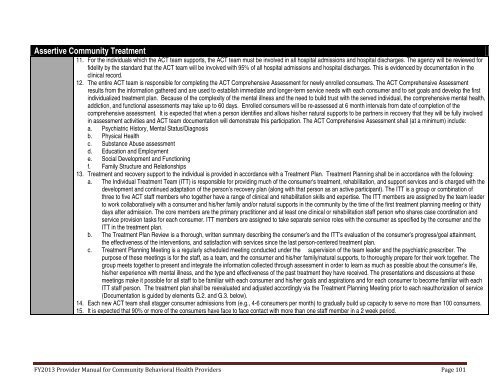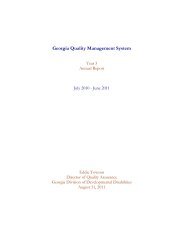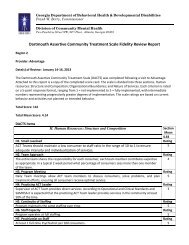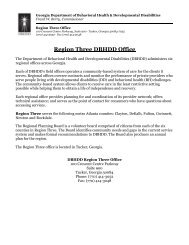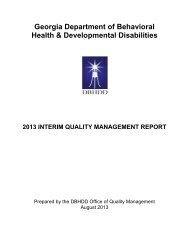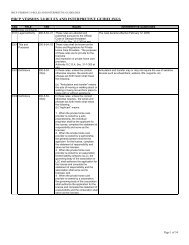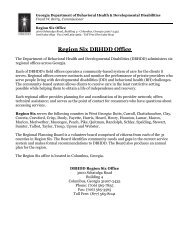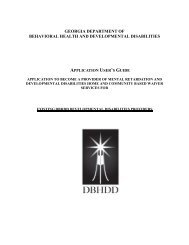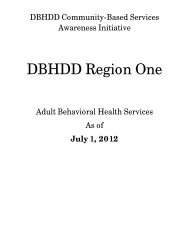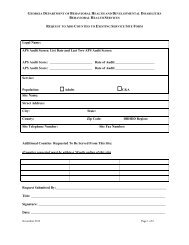Assertive Community Treatmentsubcontractor/1099 employee). See Item 2 above.ClinicalOperations1. Individuals receiving this service must have a qualifying diagnosis present in the medical record prior to the initiation <strong>of</strong> services. The verified diagnosis must begiven by persons identified in O.C.G.A Practice Acts as qualified to provide a diagnosis. These practitioners include a licensed psychologist, a physician or a PA orAPRN (NP <strong>and</strong> CNS-PMH) working in conjunction with a physician with an approved job description or protocol.2. ACT Teams must incorporate assertive engagement techniques to identify, engage, <strong>and</strong> retain the most difficult to engage consumers which include using streetoutreach approaches <strong>and</strong> legal mechanisms such as outpatient commitment <strong>and</strong> collaboration with parole <strong>and</strong> probation <strong>of</strong>ficers.ClinicalOperations,continued3. Because ACT-eligible individuals may be difficult to engage, the initial treatment/recovery plan for an individual may be more generic at the onset <strong>of</strong>treatment/support. It is expected that the treatment plan be individualized <strong>and</strong> recovery-oriented after the team becomes engaged with the individual <strong>and</strong> comes toknow the individual. The allowance for “generic” content <strong>of</strong> the IRP shall not extend beyond one initial authorization period.4. Because many individuals served may have a mental illness <strong>and</strong> co-occurring addiction disorder, the ACT team may not discontinue services to any individual basedsolely upon a relapse in his/her addiction recovery.5. ACT Teams must be designed to deliver services in various environments, such as homes, schools, homeless shelters, <strong>and</strong> street locations. The provider shouldkeep in mind that individuals may prefer to meet staff at a community location other than their homes or other conspicuous locations (e.g. their place <strong>of</strong> employmentor school), especially if staff drive a vehicle that is clearly marked as a state or agency vehicle, or if staff must identify themselves <strong>and</strong> their purpose to gain access tothe individual in a way that may potentially embarrass the individual or breech the individual’s privacy/confidentiality. Staff should be sensitive to <strong>and</strong> respectful <strong>of</strong>individuals’ privacy/confidentiality rights <strong>and</strong> preferences in this regard to the greatest extent possible (e.g. if staff must meet with an individual during their work time,mutually agree upon a meeting place nearby that is the least conspicuous from the individual’s point <strong>of</strong> view).6. The organization must have policies that govern the provision <strong>of</strong> services in natural settings <strong>and</strong> can document that it respects consumers’ <strong>and</strong>/or families’ right toprivacy <strong>and</strong> confidentiality when services are provided in those settings.7. Each ACT provider must have policies <strong>and</strong> procedures governing the provision <strong>of</strong> outreach services, including methods for protecting the safety <strong>of</strong> staff that engagein outreach activities.8. The organization must have established procedures/protocols for h<strong>and</strong>ling emergency <strong>and</strong> crisis situations that describe methods for supporting <strong>and</strong> h<strong>and</strong>lingindividuals who require psychiatric hospitalization <strong>and</strong>/or crisis stabilization.9. The organization must have an Assertive Community Treatment Organizational Plan that addresses the following descriptions:a. Particular rehabilitation, recovery <strong>and</strong> resource coordination models utilized, types <strong>of</strong> intervention practiced, <strong>and</strong> typical daily schedule for staffb. Staffing pattern <strong>and</strong> how staff are deployed to assure that the required staff-to-consumer ratios are maintained, including how unplanned staff absences,illnesses, <strong>and</strong> emergencies are accommodatedc. Hours <strong>of</strong> operation, the staff assigned, <strong>and</strong> types <strong>of</strong> services provided to consumers, families, <strong>and</strong>/or guardiansd. How the plan for services is modified or adjusted to meet the needs specified in the Individualized Recovery Plane. Inter-team communication plan regarding consumer support (e.g., e-mail, team staffings, staff safety plan such as check-in protocols etc.)f. A physical health management plang. How the organization will integrate consumers into the community including assisting consumers in preparing for employmenth. How the organization (team) will respond to crisis for individuals served.10. The ACT team is expected to work with informal support systems at least 2 to 4 times a month with or without the consumer present to provide support <strong>and</strong> skilltraining as necessary to assist the consumer in his or her recovery (i.e., family, l<strong>and</strong>lord, employers, probation <strong>of</strong>ficers). If the consumer is not an engaged participantin this contact, the service shall not be billed.FY2013 Provider Manual for Community <strong>Behavioral</strong> <strong>Health</strong> Providers Page 100
Assertive Community Treatment11. For the individuals which the ACT team supports, the ACT team must be involved in all hospital admissions <strong>and</strong> hospital discharges. The agency will be reviewed forfidelity by the st<strong>and</strong>ard that the ACT team will be involved with 95% <strong>of</strong> all hospital admissions <strong>and</strong> hospital discharges. This is evidenced by documentation in theclinical record.12. The entire ACT team is responsible for completing the ACT Comprehensive Assessment for newly enrolled consumers. The ACT Comprehensive Assessmentresults from the information gathered <strong>and</strong> are used to establish immediate <strong>and</strong> longer-term service needs with each consumer <strong>and</strong> to set goals <strong>and</strong> develop the firstindividualized treatment plan. Because <strong>of</strong> the complexity <strong>of</strong> the mental illness <strong>and</strong> the need to build trust with the served individual, the comprehensive mental health,addiction, <strong>and</strong> functional assessments may take up to 60 days. Enrolled consumers will be re-assessed at 6 month intervals from date <strong>of</strong> completion <strong>of</strong> thecomprehensive assessment. It is expected that when a person identifies <strong>and</strong> allows his/her natural supports to be partners in recovery that they will be fully involvedin assessment activities <strong>and</strong> ACT team documentation will demonstrate this participation. The ACT Comprehensive Assessment shall (at a minimum) include:a. Psychiatric History, Mental Status/Diagnosisb. Physical <strong>Health</strong>c. Substance Abuse assessmentd. Education <strong>and</strong> Employmente. Social Development <strong>and</strong> Functioningf. Family Structure <strong>and</strong> Relationships13. Treatment <strong>and</strong> recovery support to the individual is provided in accordance with a Treatment Plan. Treatment Planning shall be in accordance with the following:a. The Individual Treatment Team (ITT) is responsible for providing much <strong>of</strong> the consumer's treatment, rehabilitation, <strong>and</strong> support services <strong>and</strong> is charged with thedevelopment <strong>and</strong> continued adaptation <strong>of</strong> the person’s recovery plan (along with that person as an active participant). The ITT is a group or combination <strong>of</strong>three to five ACT staff members who together have a range <strong>of</strong> clinical <strong>and</strong> rehabilitation skills <strong>and</strong> expertise. The ITT members are assigned by the team leaderto work collaboratively with a consumer <strong>and</strong> his/her family <strong>and</strong>/or natural supports in the community by the time <strong>of</strong> the first treatment planning meeting or thirtydays after admission. The core members are the primary practitioner <strong>and</strong> at least one clinical or rehabilitation staff person who shares case coordination <strong>and</strong>service provision tasks for each consumer. ITT members are assigned to take separate service roles with the consumer as specified by the consumer <strong>and</strong> theITT in the treatment plan.b. The Treatment Plan Review is a thorough, written summary describing the consumer’s <strong>and</strong> the ITT’s evaluation <strong>of</strong> the consumer’s progress/goal attainment,the effectiveness <strong>of</strong> the interventions, <strong>and</strong> satisfaction with services since the last person-centered treatment plan.c. Treatment Planning Meeting is a regularly scheduled meeting conducted under the supervision <strong>of</strong> the team leader <strong>and</strong> the psychiatric prescriber. Thepurpose <strong>of</strong> these meetings is for the staff, as a team, <strong>and</strong> the consumer <strong>and</strong> his/her family/natural supports, to thoroughly prepare for their work together. Thegroup meets together to present <strong>and</strong> integrate the information collected through assessment in order to learn as much as possible about the consumer’s life,his/her experience with mental illness, <strong>and</strong> the type <strong>and</strong> effectiveness <strong>of</strong> the past treatment they have received. The presentations <strong>and</strong> discussions at thesemeetings make it possible for all staff to be familiar with each consumer <strong>and</strong> his/her goals <strong>and</strong> aspirations <strong>and</strong> for each consumer to become familiar with eachITT staff person. The treatment plan shall be reevaluated <strong>and</strong> adjusted accordingly via the Treatment Planning Meeting prior to each reauthorization <strong>of</strong> service(Documentation is guided by elements G.2. <strong>and</strong> G.3. below).14. Each new ACT team shall stagger consumer admissions from (e.g., 4-6 consumers per month) to gradually build up capacity to serve no more than 100 consumers.15. It is expected that 90% or more <strong>of</strong> the consumers have face to face contact with more than one staff member in a 2 week period.FY2013 Provider Manual for Community <strong>Behavioral</strong> <strong>Health</strong> Providers Page 101
- Page 1 and 2:
Georgia Department of Behavioral He
- Page 3 and 4:
UPDATED FOR JULY 1, 2013SUMMARY OF
- Page 5 and 6:
C&A Core ServicesBehavioral Health
- Page 7 and 8:
Community Supportsupports;9) Assist
- Page 9 and 10:
Community SupportServiceAccessibili
- Page 11 and 12:
Community Transition Planningv. App
- Page 13 and 14:
Diagnostic AssessmentTransactionCod
- Page 15 and 16:
Family Outpatient Services: Family
- Page 17 and 18:
Family Outpatient Services: Family
- Page 19 and 20:
Family Outpatient Services: Family
- Page 21 and 22:
Group Outpatient Services: Group Co
- Page 23 and 24:
Group Outpatient Services: Group Tr
- Page 25 and 26:
Individual CounselingServiceDefinit
- Page 27 and 28:
Medication AdministrationAdmissionC
- Page 29 and 30:
Nursing Assessment and Health Servi
- Page 31 and 32:
Continuing StayCriteriaDischargeCri
- Page 33 and 34:
Psychiatric TreatmentAdditionalMedi
- Page 35 and 36:
Service Plan DevelopmentPractitione
- Page 37 and 38:
CHILD & ADOLESCENT SPECIALTY SERVIC
- Page 39 and 40:
Behavioral AssistanceAssistance.Ser
- Page 41 and 42:
Crisis Stabilization Unit (CSU) Ser
- Page 43 and 44:
Crisis Stabilization Unit (CSU) Ser
- Page 45 and 46:
Intensive Family Intervention5. Bec
- Page 47 and 48:
Intensive Family Interventionconfid
- Page 49 and 50: Intensive Family Intervention10. Th
- Page 51 and 52: Structured Activity SupportsService
- Page 53 and 54: Structured Residential SupportsClin
- Page 55 and 56: Substance Abuse Intensive Outpatien
- Page 57 and 58: Substance Abuse Intensive Outpatien
- Page 59 and 60: Substance Abuse Intensive Outpatien
- Page 61 and 62: RequiredComponents1. Any diagnosis
- Page 63 and 64: Community Support3. Contact must be
- Page 65 and 66: Community Transition Planning3. Jai
- Page 67 and 68: ContinuingStay CriteriaDischargeCri
- Page 69 and 70: Family Outpatient Services: Family
- Page 71 and 72: Family Outpatient Services: Family
- Page 73 and 74: Family Outpatient Services: Family
- Page 75 and 76: Group Outpatient Services: Group Co
- Page 77 and 78: Group Outpatient Services: Group Tr
- Page 79 and 80: Individual CounselingServiceDefinit
- Page 81 and 82: StaffingRequirementsServiceAccessib
- Page 83 and 84: Medication Administrationliving.Req
- Page 85 and 86: Nursing Assessment and Health Servi
- Page 87 and 88: Psychiatric Treatmentbehaviormodify
- Page 89 and 90: Psychological Testing: Psychologica
- Page 91 and 92: Service Plan DevelopmentRecovery pl
- Page 93 and 94: Ambulatory Substance Abuse Detoxifi
- Page 95 and 96: Assertive Community Treatmente. Ass
- Page 97 and 98: Assertive Community Treatment• Di
- Page 99: Assertive Community Treatment• di
- Page 103 and 104: Assertive Community Treatmentin whi
- Page 105 and 106: Consumer/Family AssistanceTransacti
- Page 107 and 108: Consumer/Family Assistancecriticaln
- Page 109 and 110: Crisis Stabilization Unit Servicesb
- Page 111 and 112: ClinicalExclusionsDocumentationRequ
- Page 113 and 114: Peer Support Services4. Individual
- Page 115 and 116: Peer Support ServicesClinicalOperat
- Page 117 and 118: Psychosocial RehabilitationUnit Val
- Page 119 and 120: Psychosocial Rehabilitationmust dem
- Page 121 and 122: Psychosocial RehabilitationBilling
- Page 123 and 124: Residential: Independent Residentia
- Page 125 and 126: Residential: Intensive Residential
- Page 127 and 128: Residential: Semi-Independent Resid
- Page 129 and 130: Residential Substance Detoxificatio
- Page 131 and 132: ServiceDefinitionAdmissionCriteriaC
- Page 133 and 134: AdmissionCriteria,continuedContinui
- Page 135 and 136: 1. It is expected that the transiti
- Page 137 and 138: DocumentationRequirements1. Every a
- Page 139 and 140: FY2013 Provider Manual for Communit
- Page 141 and 142: TABLE B: Physicians, Physician’s
- Page 143 and 144: COMMUNITY SERVICE STANDARDS FOR ALL
- Page 145 and 146: 3. The provider details the desired
- Page 147 and 148: 7. The provider’s practice of cul
- Page 149 and 150: c. Is not permitted in developmenta
- Page 151 and 152:
2. Policies, procedures, and guidel
- Page 153 and 154:
3. Safe transport of persons served
- Page 155 and 156:
iv. There are safeguards utilized f
- Page 157 and 158:
i. The date and time the medication
- Page 159 and 160:
Training Requirements for all Staff
- Page 161 and 162:
Qualified MedicationAide (QMA)Psych
- Page 163 and 164:
Addiction CounselorTrainees (ACT)Hi
- Page 165 and 166:
CADC, CCADC, CAC II or MAC and is r
- Page 167 and 168:
practitioner), s/he could bill as a
- Page 169 and 170:
COMMUNITY SERVICE STANDARDS FOR ALL
- Page 171 and 172:
4. ORDER/RECOMMENDATION FOR COURSE
- Page 173 and 174:
ii. Services, supports, and treatme
- Page 175 and 176:
xv.xvi.xvii.Recorded changes - Any


